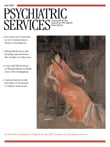CHADD and Public Attitudes About ADHD
To the Editor: Two articles on attention-deficit hyperactivity disorder (ADHD) in the May 2007 issue of
Psychiatric Services (
1,
2 ) affirm and expand on previous research about public attitudes and knowledge of this disorder. This research will positively influence the activities of my organization, CHADD (Children and Adults With Attention-Deficit/Hyperactivity Disorder), a family-based organization with 14,000 members and 1,200 professional members that was founded in 1987.
McLeod and associates (
1 ), who noted critics' claim that ADHD is overdiagnosed, compared national estimated prevalence with medication use and argued that ADHD is actually underdiagnosed. Other mainstream researchers have arrived at the same findings. Missing from this analysis, however, is the more difficult and significant issue of the tremendous variation in medication utilization, which two national studies have documented. The first, the result of14 months of work by reporters from the
Cleveland Plain Dealer (
3 ), gets little attention because of the journalistic credentials of the researchers. This study, which documented ADHD medication use in every U.S. county, found that in some counties the number of people being prescribed medication was three times the expected rate, whereas in other counties not a single individual was receiving medication. There are many possible reasons for this variance, including inconsistency in implementing evidence-based treatment guidelines.
In the second national study the authors conclude that variation in stimulant use among children is second only to variation in cough-cold-allergy prescription use (
4 ). The authors state that the reasons for regional variation are not known. They postulate that "differences in state controlled substance abuse laws, anti-Ritalin campaigns, direct-to-consumer advertising, physician practice style, the values, beliefs, and expectations of adult caregivers" are the reasons—highlighting the importance of this new research in
Psychiatric Services on stigma and public beliefs and attitudes.
McLeod and associates conclude that "future media and educational efforts should seek to provide accurate information about ADHD." It is this understanding that has led the Centers for Disease Control and Prevention (CDC) to finance the National Resource Center on ADHD (www.help4adhd.org), a project of CHADD. During any given month, more than 135,000 unique users visit the CHADD Web sites, and we individually respond to an average of 880 people making 1,150 discrete inquiries. To counter stigma, CHADD hosts support groups, peer public education forums, and parent-to-parent training. In addition, through CHADD's advocacy with the U.S. Congress, the CDC is currently financing two community-based studies to examine trends in the use of ADHD medications (
5 ).
In the second article in the May issue, dosReis and associates (
2 ) provide helpful insights into the decision process used by urban African-American families when confronted with the possibility of ADHD. The four "distinct patterns" of decision are used by all families, but these researchers documented that culture, race, and community influence these patterns.
CHADD's experience as a national resource center and a family membership organization affirms the validity of the four distinct processes. The following statements are based on six-and-a-half years of my personal experience, which indicates that follow-up studies are needed on the impact of severity of disability and of co-occurring disorders on a parent's tendency to take one of dosReis's decision-making approaches over the other three. Those whose orientation is "immediate resolution" often have children experiencing less severe forms of ADHD, without co-occurring disorders, whose initial identification was made by behaviors interfering with academic performance. Those whose orientation is "pragmatic management" frequently have children with more severe ADHD, often with co-occurring disorders, and have come to realize that their child's problems began before they entered school and are chronic and long lasting. Those with "attributional ambivalence" seem embarrassed by the possibility of ADHD, do not have families and communities open to the biological underpinnings of ADHD, or are skeptical or afraid of medications and thus are willing to first try alternative interventions.
CHADD has little experience with agencies of government using "coerced conformance"—the fourth orientation. We do hear from parents who claim that they were told by their child's teacher to place their child on medication. Our response is that the child should receive an independent medical evaluation and that those making medical recommendations should do so within their sphere of professional competence and training. CHADD has recently published the CHADD Educator's Manual on ADHD: An In-depth Look From an Educational Perspective (www.chadd.org/store).
During the past six years, to better inform the public about ADHD and to build a social movement to assist all persons with ADHD, CHADD has conducted 17 community forums targeted to the African-American and Hispanic-Latino communities and has developed a variety of partnerships with organizations representing these two communities. The research by McLeod and colleagues and dosReis and associates will help us with these efforts.

